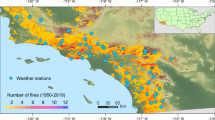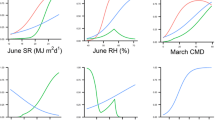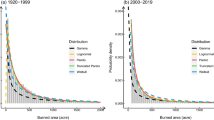Abstract
Wildfire risks for California under four climatic change scenarios were statistically modeled as functions of climate, hydrology, and topography. Wildfire risks for the GFDL and PCM global climate models and the A2 and B1 emissions scenarios were compared for 2005–2034, 2035–2064, and 2070–2099 against a modeled 1961–1990 reference period in California and neighboring states. Outcomes for the GFDL model runs, which exhibit higher temperatures than the PCM model runs, diverged sharply for different kinds of fire regimes, with increased temperatures promoting greater large fire frequency in wetter, forested areas, via the effects of warmer temperatures on fuel flammability. At the same time, reduced moisture availability due to lower precipitation and higher temperatures led to reduced fire risks in some locations where fuel flammability may be less important than the availability of fine fuels. Property damages due to wildfires were also modeled using the 2000 U.S. Census to describe the location and density of residential structures. In this analysis the largest changes in property damages under the climate change scenarios occurred in wildland/urban interfaces proximate to major metropolitan areas in coastal southern California, the Bay Area, and in the Sierra foothills northeast of Sacramento.
Similar content being viewed by others
References
Balling RC, Meyer GA, Wells SG (1992) Relation of surface climate and burned area in Yellowstone National Park. Agric For Meteorol 60:285–293
Brillinger DR, Preisler HK, Benoit JW (2003) Risk assessment: a forest fire example. In Science and Statistics, Institute of Mathematical Statistics Lecture Notes. Monograph Series
California Board of Forestry (1995) California fire plan, pp 125
Cayan D, Luers AL, Hanemann M, Franco G, Croes B (2006) Scenario of climate change in California: overview. California Energy Commission
Chambers JM, Hastie TJ (eds.) (1992) Statistical models in S. Wadsworth and Brooks/Cole, Pacific Grove, CA
Dettinger MD (2005) From climate change spaghetti to climate-change distributions for 21st Century California. San Francisco Estuary and Watershed Science. 3(1) Article 4. http://repositories.cdlib.org/jmie/sfews/vol3/iss1/art4
Dobson AJ (1990) An introduction to generalized linear models. Chapman and Hall, London
Donnegan JA, Veblen TT, Sibold SS (2001) Climatic and human influences on fire history in Pike National Forest, Central Colorado. Can J For Res 31:527–1539
Hastie TJ, Tibshirani R, Friedman J (2001) The elements of statistical learning. data mining, inference, and prediction. Springer, New York, p 533
Heyerdahl EK, Brubaker LB, Agee JK (2002) Annual and decadalclimate forcing of historical fire regimes in the interior PacificNorthwest, USA.. Holocene 12:597–604
Houghton JT et al (Eds) (2001) IPCC climate change: the scientific basis. Cambridge University Press, Cambridge, United Kingdom and New York, NY, USA
Liang X, Lettenmaier DP, Wood E, Burges SJ (1994) A simple hydrologically based model of land surface water and energy fluxes for general circulation models. J Geophys Res 99:14415–14428
Liang X, Lettenmaier DP, Wood EF (1996) One-dimensional statistical dynamic representation of subgrid spatial variability of precipitation in the two-layer variable infiltration capacity model. J Geophys Res 101:21403–21422
Lofing N (2006) Placer touts its low poverty, jobless rates. Sacramento Bee January 5, 2006, p. G1
Maurer EP, Wood AW, Adam JC, Lettenmaier DP, Nijssen B (2002) A long-term hydrologically based dataset of land surface fluxes and states for the conterminous United States. J Clim 15:3237–3251
Miller N, Schlegel N (2006) Climate change projected Santa Ana fire weather occurrence
National Assessment Synthesis Team (2000) Climate change impacts on the United States: the potential consequences of climate variability and change. US GCRP, Washington DC
NOAA (2005) http://www.ncdc.noaa.gov/img/reports/billion/billion2005.pdf
Preisler HK, Westerling AL (2007) Statistical model for forecasting monthly large wildfire events in the Western United States. J Appl Meteorol Climatol 46(7):1020–1030
Preisler HK, Brillinger DR, Burgan RE, Benoit JW (2004) Probability based models for estimating wildfire risk. Int J Wildland Fire 13:133–142
R Development Core Team (2004). R: A language and environment for statistical computing. R Foundation for Statistical Computing, Vienna, Austria. ISBN 3-900051-07-0, URL http://www.R-project.org
Running SW (2006) Is global warming causing more, larger wildfires? Science 313:927–928
Sheffield J, Goteti G, Wen FH, Wood EF (2004) A simulated soil moisture based drought analysis for the United States. J Geophys Res 109:D24108
Swetnam TW (1993) Fire history and climate change in giant sequoia groves. Science 262:885–889
Stewart SI, Radeloff VC, Hammer RB (2006) The wildland–urban interface in the United States. Ecol Appl 15(3):799–805
Swetnam TW, Betancourt JL (1998) Mesoscale disturbance and ecological response to decadal climatic variability in the American Southwest. J Climate 11:3128–3147
Westerling AL, Cayan DR, Gershunov A, Dettinger MD, Brown TJ (2001) Statistical forecast of the 2001 western wildfire season using principal components regression. Experimental Long-Lead Forecast Bulletin, 10:71–75
Westerling AL, Gershunov A, Cayan DR, Barnett TP (2002) Long lead statistical forecasts of Western U.S. wildfire area burned. Int J Wildland Fire 11(3, 4):257–266
Westerling AL, Brown TJ, Gershunov A, Cayan DR, Dettinger MD (2003a) Climate and wildfire in the Western United States. Bull Am Meteorol Soc 84(5):595–604
Westerling AL, Gershunov A, Cayan DR (2003b) Statistical forecasts of the 2003 western wildfire season using canonical correlation analysis. Experimental Long-Lead Forecast Bulletin, 12(1, 2)
Westerling AL, Hidalgo HG, Cayan DR, Swetnam TW (2006) Increases in Western US forest wildfire associated with warming and advances in the timing of spring. Science 313:940–943
Wood AW, Maurer EP, Kumar A, Lettenmaier DP (2002) Long-range experimental hydrologic forecasting for the eastern United States. J Geophys Res 107:4429
Wood AW, Leung LR, Sridhar V, Lettenmaier DP (2004) Hydrologic implications of dynamical and statistical approaches to downscaling climate model outputs. Clim Change 62:189–216
Author information
Authors and Affiliations
Corresponding author
Rights and permissions
About this article
Cite this article
Westerling, A.L., Bryant, B.P. Climate change and wildfire in California. Climatic Change 87 (Suppl 1), 231–249 (2008). https://doi.org/10.1007/s10584-007-9363-z
Received:
Accepted:
Published:
Issue Date:
DOI: https://doi.org/10.1007/s10584-007-9363-z




